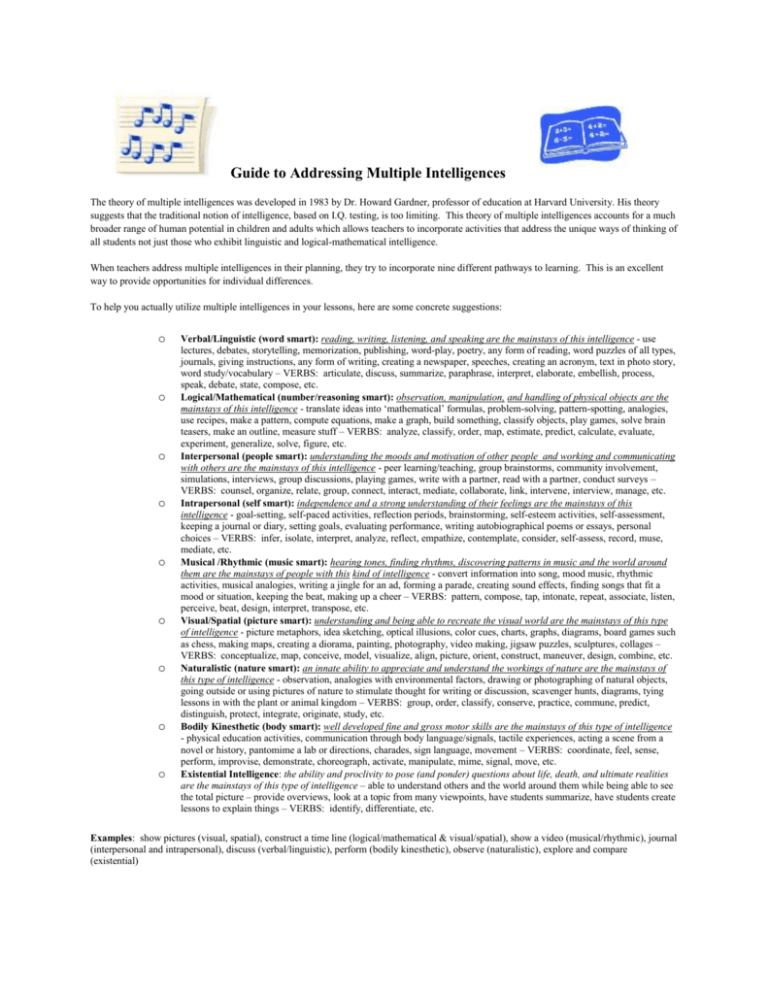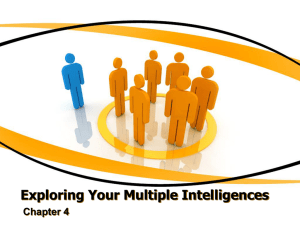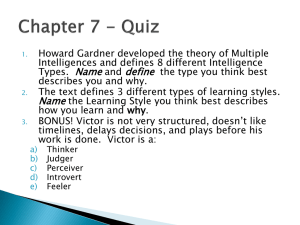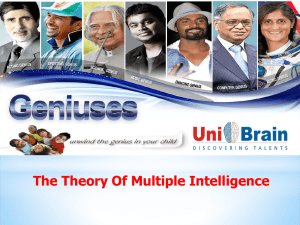Word - SEQL
advertisement

Guide to Addressing Multiple Intelligences The theory of multiple intelligences was developed in 1983 by Dr. Howard Gardner, professor of education at Harvard University. His theory suggests that the traditional notion of intelligence, based on I.Q. testing, is too limiting. This theory of multiple intelligences accounts for a much broader range of human potential in children and adults which allows teachers to incorporate activities that address the unique ways of thinking of all students not just those who exhibit linguistic and logical-mathematical intelligence. When teachers address multiple intelligences in their planning, they try to incorporate nine different pathways to learning. This is an excellent way to provide opportunities for individual differences. To help you actually utilize multiple intelligences in your lessons, here are some concrete suggestions: o o o o o o o o o Verbal/Linguistic (word smart): reading, writing, listening, and speaking are the mainstays of this intelligence - use lectures, debates, storytelling, memorization, publishing, word-play, poetry, any form of reading, word puzzles of all types, journals, giving instructions, any form of writing, creating a newspaper, speeches, creating an acronym, text in photo story, word study/vocabulary – VERBS: articulate, discuss, summarize, paraphrase, interpret, elaborate, embellish, process, speak, debate, state, compose, etc. Logical/Mathematical (number/reasoning smart): observation, manipulation, and handling of physical objects are the mainstays of this intelligence - translate ideas into ‘mathematical’ formulas, problem-solving, pattern-spotting, analogies, use recipes, make a pattern, compute equations, make a graph, build something, classify objects, play games, solve brain teasers, make an outline, measure stuff – VERBS: analyze, classify, order, map, estimate, predict, calculate, evaluate, experiment, generalize, solve, figure, etc. Interpersonal (people smart): understanding the moods and motivation of other people and working and communicating with others are the mainstays of this intelligence - peer learning/teaching, group brainstorms, community involvement, simulations, interviews, group discussions, playing games, write with a partner, read with a partner, conduct surveys – VERBS: counsel, organize, relate, group, connect, interact, mediate, collaborate, link, intervene, interview, manage, etc. Intrapersonal (self smart): independence and a strong understanding of their feelings are the mainstays of this intelligence - goal-setting, self-paced activities, reflection periods, brainstorming, self-esteem activities, self-assessment, keeping a journal or diary, setting goals, evaluating performance, writing autobiographical poems or essays, personal choices – VERBS: infer, isolate, interpret, analyze, reflect, empathize, contemplate, consider, self-assess, record, muse, mediate, etc. Musical /Rhythmic (music smart): hearing tones, finding rhythms, discovering patterns in music and the world around them are the mainstays of people with this kind of intelligence - convert information into song, mood music, rhythmic activities, musical analogies, writing a jingle for an ad, forming a parade, creating sound effects, finding songs that fit a mood or situation, keeping the beat, making up a cheer – VERBS: pattern, compose, tap, intonate, repeat, associate, listen, perceive, beat, design, interpret, transpose, etc. Visual/Spatial (picture smart): understanding and being able to recreate the visual world are the mainstays of this type of intelligence - picture metaphors, idea sketching, optical illusions, color cues, charts, graphs, diagrams, board games such as chess, making maps, creating a diorama, painting, photography, video making, jigsaw puzzles, sculptures, collages – VERBS: conceptualize, map, conceive, model, visualize, align, picture, orient, construct, maneuver, design, combine, etc. Naturalistic (nature smart): an innate ability to appreciate and understand the workings of nature are the mainstays of this type of intelligence - observation, analogies with environmental factors, drawing or photographing of natural objects, going outside or using pictures of nature to stimulate thought for writing or discussion, scavenger hunts, diagrams, tying lessons in with the plant or animal kingdom – VERBS: group, order, classify, conserve, practice, commune, predict, distinguish, protect, integrate, originate, study, etc. Bodily Kinesthetic (body smart): well developed fine and gross motor skills are the mainstays of this type of intelligence - physical education activities, communication through body language/signals, tactile experiences, acting a scene from a novel or history, pantomime a lab or directions, charades, sign language, movement – VERBS: coordinate, feel, sense, perform, improvise, demonstrate, choreograph, activate, manipulate, mime, signal, move, etc. Existential Intelligence: the ability and proclivity to pose (and ponder) questions about life, death, and ultimate realities are the mainstays of this type of intelligence – able to understand others and the world around them while being able to see the total picture – provide overviews, look at a topic from many viewpoints, have students summarize, have students create lessons to explain things – VERBS: identify, differentiate, etc. Examples: show pictures (visual, spatial), construct a time line (logical/mathematical & visual/spatial), show a video (musical/rhythmic), journal (interpersonal and intrapersonal), discuss (verbal/linguistic), perform (bodily kinesthetic), observe (naturalistic), explore and compare (existential)








